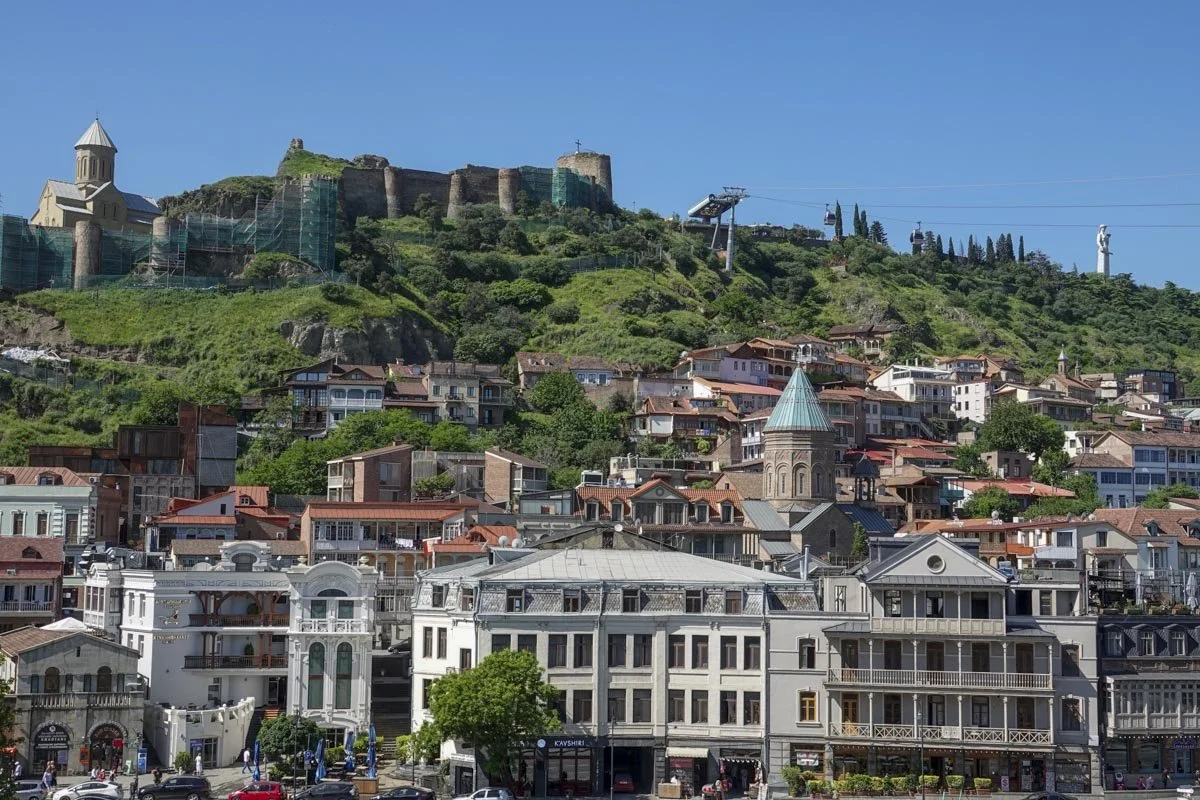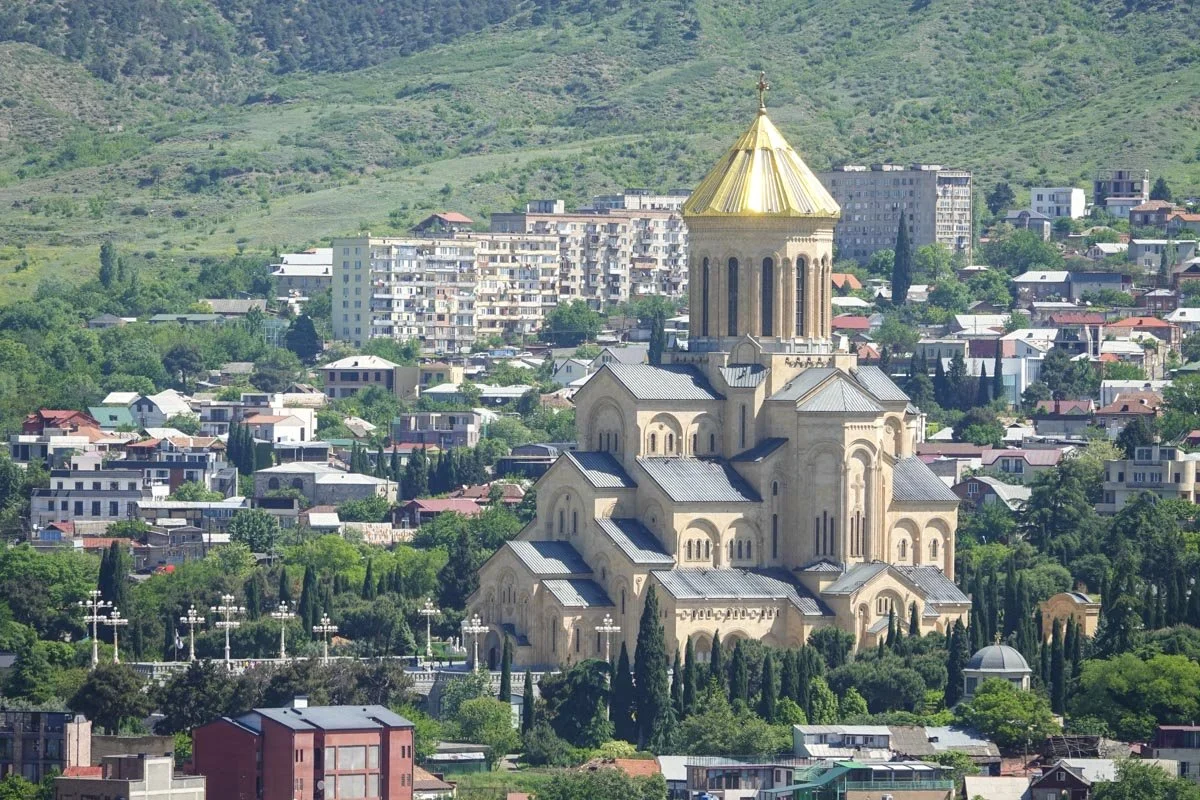Tbilisi, GEORGIA
We are now in Georgia. Yes, there is a European country named Georgia, or to be more specific, The Republic of Georgia. Georgia has been inhabited since prehistory and contains the world's earliest known sites of winemaking, gold mining, and textiles. They have one of the world's original alphabets and languages. It had many kingdoms in past ages. Georgians officially adopted Christianity in the early fourth century and are primarily Eastern Orthodox Christians. They had the usual empires flow through such as the Persians, Mongolians, Ottomans, Romans, and Russians. They are an official candidate for entry into the European Union but face some difficult obstacles, mainly due to Russian incursion that is still unsettled to this day.
From my perspective, I find it interesting that Georgia was part of Russia between 1801 and 1918, and then from 1921 to 1991. From my own perspective, I would think that after being part of Russia for some 187 years, you would consider yourselves Russians. But not a chance. These people are Georgians all the way. Even today, the two countries are at odds with each other. Russians have incurred into Georgia recently and have established military bases within Georgia's borders, in South Ossetia. That's one of the conflicts to joining the EU because to join the EU, you must have clear, established borders. At any rate, Georgia is moving onward from their Russian hangover and seems to be making good progress. My guess is that had Russia taken over the Ukraine in five days (the current war), like Putin thought he would, Georgia would now be part of Russia again. One other very interesting item is that Georgia fought in WW II on the side of Russia and the Allies. They still feel like they contributed a lot to the war effort, and lost a lot of men, but were given no credit for their fighting on the side of the Allies by Russia.
Our first and longest stop of our trip was in Tbilisi. Tbilisi is the capital and largest city of Georgia. It has around 1.2 million people in a country of around 3.7 million people. Tbilisi is located on the banks of the Kura River and was founded in the fifth century AD. It served as the capital of various Georgian kingdoms and republics before being overtaken by Russia. On a side note, we drove into Tbilisi on George W. Bush Street, as George Bush visited here when he was our President.
Tbilisi is at the crossroads of Europe and Asia and was a key location on the northern alternate route of the Silk Road. Tbilisi remains in a key location today and is an important transit route for energy and trade projects. I'm guessing that due to being a crossroads, Tbilisi and Georgia are home to people of diverse cultural, ethnic, and religious backgrounds, though still primarily Eastern Orthodox for religion. In the same vein, Tbilisi has a wide spectrum of architecture which is a mix of medieval, neoclassical, Beaux Arts, Art Nouveau, Stalinist, Russian, and Modern. I found it impressive. Tbilisi is a big city, and you will only see glimpses of it.
I'll start our tour of Tbilisi with some overview photos to give a general idea of the landscape, architecture, and history. I chose the first photo for multiple reasons. You can see the old Narikala Fortress walls on top of the hill, and a variety of buildings below. You can see several churches which are a common site in Georgia. You can see a cable car going up to the top of the mountain. We took the cable car and the next several photos were taken from the top of Sololaki Hill. I also thought that Tbilisi had a good look and feel to it.
The next two photos just show more of the extended town with a variety of architecture, the mountains, and the Kura River.
Georgia is chuck full of churches, like most of Europe, but I found the Holy Trinity Cathedral particularly impressive. We never got to visit it however.
The next photo is just to show a glimpse of some of the modern buildings in Tbilisi.
I don't, however, want to give anyone the wrong impression. Georgia was under Russia for a long time. Some of the older Russian buildings, from the Russian Empire period, were very nice buildings. But when the likes of Khruschev and Brezhnev came to power, it was function over form.
The next photo is the Mother of Georgia statue, from atop Sololaki Hill. It was originally built in 1958 to commemorate Tbilisi's 1,500th anniversary. But it was rebuilt in the 1990's. It's now a 65-foot tall, aluminum coated woman in traditional Georgian dress. She holds a bowl of wine in one hand and is brandishing a sword in the other. The wine is for those who come as friends, and the sword is for those who don't come to Georgia as friends. We most definitely came to Georgia as friends, and we enjoyed plenty of their wine!
The next building is the Music Hall. It was designed by Massimiliano Fuksas and sits in Rike Park. I was really fascinated and impressed by many of the buildings in the Caucasus and this was one of them. On a side note, and along musical lines, Azerbaijan was really taken by American Jazz music back in the 1970's. They expanded and developed their own Azerbaijani jazz, but American jazz music was their starting point.
On the lower left above, you can see one end of the Peace Bridge. This bridge stretches 490 feet over the Kura River and opened in 2010. The bridge connects Old Tbilisi and Rike Park. It was designed by Italian architect Michele De Lucchi. It's a nice walking bridge and also offers some great views of the river and town. It's also an all-weather walking bridge and very popular.
The ancient Tbilisi district of Abanotubani contains a cluster of dome-roofed brick bathhouses, built over the sulfur hot springs that gave Tbilisi its name, "warm place" in Georgian. Our guide offered to make us a reservation but when we asked about the smell, he said it was terrible. We opted to not go down into the bathhouses.
We visited the Zion Cathedral, or the Sioni Cathedral of the Dormition. It bears the name Mount Zion of Jerusalem. The cathedral is on the right bank of the Kura River. It was originally built back in the sixth century but there have been many re-buildings since then. Our guide went in first and found out that there was a funeral service underway, but the Orthodox priest told him that we could come in anyway, so we did. After we had viewed the church, we could see that others in our group were looking more extensively, so Vicky and I sat down on a bench in the back of the church. Before long, an Orthodox priest came up to Vicky and scolded her for crossing her legs as she sat on the bench. Vicky uncrossed her legs, but we never did understand the problem.
I have photos of other major buildings and streets, but like in other cities, I liked some of the side streets the best and Tbilisi had some nice ones.
You can't go to a former Russian country but that monuments and statues are major landmarks. The War Memorial in Vake Park is on the edge of Tbilisi center. The park has a long and uncertain history. It might have been a park already but in 1946, it became Victory Park, and a war memorial was installed to commemorate the Great Patriotic War (WW II). Many Georgians fought and died in the war. There was a major reconstruction project from 1981 to 1985 involving cascades and fountains plus the installation of the Mother of the Place (Victory Lady) statue at the top of the monument. Also added were eight Georgian Warrior Heroes, guarding the tomb. Now, it's undergoing another renovation, so the fountains were all empty. It was still an impressive monument.














